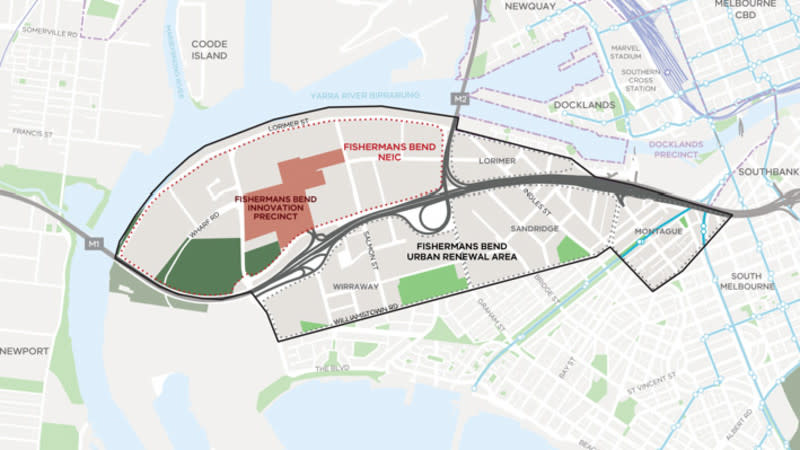
A plan to bring together all infrastructure charges levelled at developers in Melbourne’s Fishermans Bend has won city support, albeit with some caveats.
The City of Melbourne’s Future Melbourne Committee this week endorsed its submission to the Victorian Department of Transport and Planning on the development contributions plan and planning scheme for the Fishermans Bend Urban Renewal Area.
Fishermans Bend is designated as an area for the planning department to focus on redeveloping to increase residents.
It covers 480ha of land and is predicted to have 80,000 residents by 2050.
Just the Lorimer Precinct of the four precincts in the urban renewal area is within the City of Melbourne’s purview—the others fall under the City of Port Phillip.
The Development Contributions Plan (DCP) will be part of the planning scheme amendment GC224, to be determined by the state planning department.
Developers pay contributions to relevant authorities when developing a site to allow sufficient funds for public and community infrastructure needed as the area develops.
The Fishermans Bend Framework was endorsed by the state government in 2018 and is part of background documentation in the Melbourne and Port Phillip planning schemes via Amendment GC81.
The Fishermans Bend National Employment and Innovation Cluster is not part of the development contribution plan.
Development contributions in the area have been made through the Interim Development Contributions system since 2015.
With more housing needed and developers eager to proceed with projects in the area, finalising the contributions plan is imperative.

The current DCP draft consolidates all infrastructure charges into one contribution, including open-space contributions that were previously collected separately.
It also allocates $309 million to building major drainage and flood mitigation projects within the area, removing charges usually associated with Melbourne Water.
The Minister for Precincts is designated in the draft DCP as the collecting agency and the planning department secretary for project development as the development agency.
It also introduces a capped rate of $34,635 per home and $286 per square metre of non-residential development gross floor area, and identifies $2.44-billion worth of infrastructure.
Expected cost recovery is $1.75 billion with a funding gap of $698 million but the plan also lists projects as 100 per cent funded.
The designation of collection and development agents within the planning department removes any financial risk for the City of Melbourne.
While essential infrastructure projects will be funded by the DCP, “catalytic” infrastructure such as the Fishermans Bend tram and the Melbourne Metro 2 are to be funded by the state government.
Local infrastructure such as certain open spaces, minor streets, laneways and other community facilities will be funded by developers and local government.
The City of Melbourne’s submission to the department recommends that a Hartley Street-Lorimer Street neighbourhood open space, transport connections to the Sandridge precinct, the Lorimer Sport and Recreation Hub and contributions to the Meaden Street undercroft be considered for funding with a total value of $70 million.
“The recommendation is that we think that could be a good thing, subject to quite a few quibbles, and it’s important that those quibbles are addressed because if they’re not addressed, there’s quite a few significant risks to both state and local levels of government in future,” City of Melbourne councillor Rohan Leppert said.
In Melbourne and its suburbs, including Docklands, urban renewal often led to prolonged disputes between government bodies and private developers over funding infrastructure responsibilities, revealing overlooked infrastructure needs that were nobody’s responsibility, Leppert said.
There was also concern raised around new mechanisms such as the Open Space Uplift (OSU) mechanism that the City of Melbourne planning officers stated needed more testing.
“If a developer does not opt to deliver land under the OSU, the land will need to be purchased or acquired by the Victorian Government,” planning officer advice in council records said.
There was also concern that the OSU would increase demands for infrastructure and that the draft plan did not reference the housing statement which would mean it would need to account for larger targets of residents thereby also increasing the demand for infrastructure.
“If you’re extinguishing the ability to collect open space contributions [by local government], then surely we can’t be expected to pay for it down the line,” Leppert said.
“It is important we go into this negotiation of the Standing Advisory Committee in conversations with the minister and make it very clear that you cannot simultaneously extinguish the ability of the council to collect funds to pay for essential local infrastructure and upgrades and then years down the track say are that you’re going to pay for them anyway.”
Leppert also said it was imperative that a commitment to delivering and funding the Fishermans Bend tramline was part of the plan.
“Our support is contingent on the tram being built,” Leppert said.
“Fishermans Bend still has the opportunity to fail and will fail if there’s no public transport in and out of the area.”
The council also wants start and end dates for construction for the tramline to be included in the DCP.
The City of Melbourne’s submission will now go to the state planning department where planning minister Sonya Kilkenny will make the final determination.